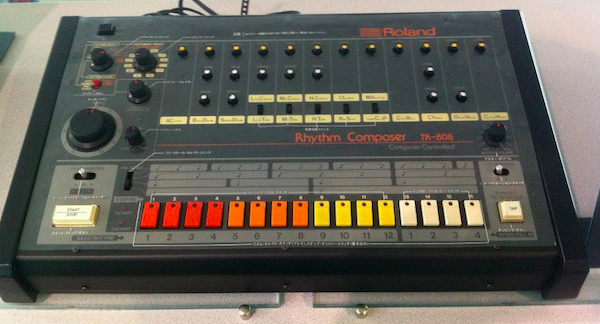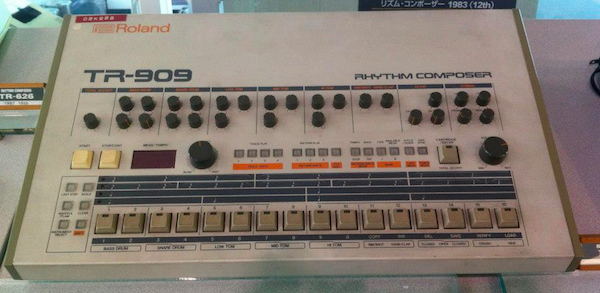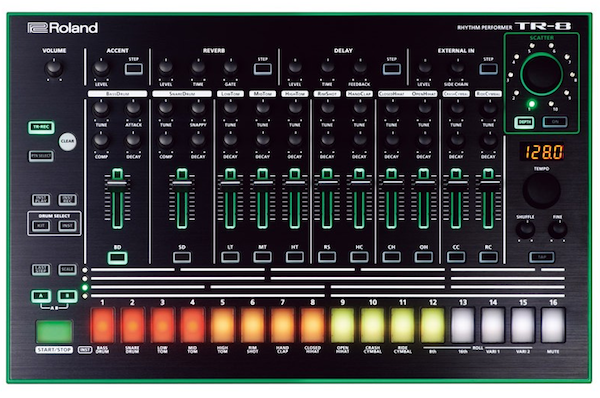ROLAND AIRA TR-8 REVIEW
Posted on Tue 18 February 2014 in entries
Roland have been teasing their new range of AIRA products for the last month and now we're finally allowed to reveal what they are! What's more is that a selection of Absolute Music staff were invited to a special, super-secret demo of the new AIRA range before the announcement, where we got to see, hear and play with them. Now that's what you call a perk of the job!
In this article, we'll talk about the brand new AIRA TR-8, which brings together Roland's classic TR-808 and TR-909 drum machines in one modern design. We'll let you know about its features, as well as what we thought of it and how it sounds.
http://www.youtube.com/watch?v=H4Ol1_qOI_g
ROLAND AIRA TR-8 - A BIT OF HISTORY
Ok, so if you're reading this article, you're probably well aware of the impact that the TR-808 and TR-909 rhythm machines have had on electronic music as we know it today. However, just in case you've stumbled upon this review by chance, I'll give you a brief bit of background information.
First produced in 1981, the Roland TR-808 used analogue synthesis to create its percussive sounds. It was designed to provide rhythm accompaniments for bands, but as technology improved and other companies began to release machines with more realistic drum sounds, many would have predicted the end for the 808. How wrong those people would have been!

Not only did electronic dance music producers begin to use the percussive sounds of the TR-808 to form the foundations of their grooves, but experimental artists also started using its sounds in a more melodic way, to form other key elements of their tracks. Arguably the most famous example would be the TR-808 bass drum, which, with its huge, warm, analogue boom, was sampled by too many producers to mention and used as a bassline that was so big that it would blow the face off a kitten!
The TR-808 was hugely influential in electronic genres such as house, techno and hip hop and you'll still find TR-808 sounds popping up in tracks today. In fact, such was its influence that it has had bands named in its honour (e.g. 808 State) and countless lyrics written about! The list of artists who have used it in their work reads like a who's who of electronic dance music producers, including The Prodigy, Orbital, Faithless, A Guy Called Gerald, Dr. Dre, Richie Hawtin, Kraftwerk, Jean Michel Jarre and many, MANY more.
Roland certainly had a BIG job to follow up the TR-808 when it was discontinued, but the TR-909 didn't disappoint! In fact, the TR-909 became the sound of house and techno music, and you'll still hear samples of its awesome percussive sounds in countless tracks today. Again, the TR-909 was an analogue drum machine that delivered a huge, punchy sound. However, it also made use of samples for the cymbal, as the designer confessed that he was struggling to create the sound that he wanted using synthesis.

ROLAND AIRA TR-8 - THE EVOLUTION
It's no secret that purchasing an original second-hand TR-808 or TR-909 rhythm machine is not a cheap option by any stretch of the imagination... in fact, you'll be doing well if you can get your hands on either for less than £2000. Because of this, many modern producers opt for using samples from the original machine, which give you an authentic sound, but is rather limiting in that you cannot tweak the sounds in the same way that you can using the original units. There are also a number of software emulations of the TR-808 and TR-909; however, these don't give you the hands-on workflow of the original machines, which for many people is half the fun of creating grooves... this is where the TR8 comes in though.
The Roland TR-8 is the re-imagined vision of both the TR-808 and TR-909, providing authentic sounds, new features for the modern era and a hands-on workflow that improves on the original units.
But, does it sound like the originals?
ROLAND AIRA TR-8 - SOUNDS
Firstly, I want to bust any myths... the TR-8 is a digital machine, which means that unlike the original units, it does not make use of any analogue circuitry. This must have presented a huge challenge for Roland, as digitally modelling an analogue machine is no easy feat. Analogue sounds have a characteristic depth and warmth that traditional digital signals do not. However, the good news is that as technology and techniques improve, software developers are getting better and better at modelling analogue characteristics with digital algorithms. Take Universal Audio's range of software plug-ins for example, which are designed to model classic bits of analogue gear... there aren't many in the industry that would argue that they can tell the difference, apart from perhaps that the emulations have less noise to deal with! Also, with a wealth of analogue-modelling synths on the market, I've heard plenty of sounds that would certainly fool me into thinking they were analogue if I didn't know any better. What's more, the difference between real analogue and digital sounds imitating analogue becomes even more difficult to spot once you start mixing them with other elements to create a full track.
So, with this in mind, how have Roland gone about making sure that the TR-8 lives up to the hype?
In fact, Roland have gone to extreme lengths to make sure that the TR-8 is as close in sound to the originals as possible, especially considering that the technology is different. By taking original TR-808 and TR-909 units and analysing how each section of the analogue circuit affected the sound, the Roland engineers were able to build up a jigsaw of how the machines' unique sounds were produced. They therefore worked in steps, to build small algorithms that precisely modelled individual sections of the original analogue instrument. At each stage they could then analyse and compare how their algorithm performed against the original circuit, by measuring waveforms and listening to results. This methodical approach meant that the original analogue circuit could be built-up piece-by-piece, which should then hopefully result in something that sounds exactly like the original.
So, I guess you're now all itching to know how authentic the sounds of the TR-8 are?
I've got to admit that the Roland engineers have done a superb job here. The kicks are deep, in-you-face and subby and the snares are powerful and snappy. I've also been told that the 909 cymbal is exactly the same one that was sampled for the original TR-909 unit, so you can't get more authentic than that!
Could I tell the difference between an original TR-808/TR-909 unit and the TR-8? Unfortunately there wasn't an original TR-808 and TR-909 to compare it with at the time, although I would be really interested in performing blind tests. What I would say is that if someone had the TR-8 covered up and told me that it was an authentic analogue TR-808/TR-909, then I would have believed them as it had a fantastic old-skool sound.
In my opinion, considering the TR-8 costs £399 and an original TR-808 and TR-909 will set you back over £4000 for the pair, it's a real no-brainer as to which one I would go for if I wanted a hands-on drum machine experience with 808 and 909 sounds. Even if I did manage to compare the TR-8 with an analogue Roland drum machine, I know that the sonic differences (if any) would be extremely minimal, so there is no way that the original will sound over £3600 better than the TR-8!
In fact, if you haven't already watched it, check out the TR-8 in the Point Blank Music School video at the start of this article to hear (and see) it in action.
The Roland TR-8 comes with 16 kits made up of 11 instrument types. When creating your grooves, you also have the flexibility to mix and match 808 and 909 sounds, for some awesome hybrid beats.
ROLAND AIRA TR-8 - THE BUILD
The TR-8 Rhythm Performer feels extremely well built, which is very important to me. Although I champion the idea that the sound is the most important thing, I think that a cheap feel and loose controls can be a real fun-killer. After all, when playing with audio gear, I don't want to be worrying about whether the faders are going to snap off in my hand! Thankfully, the TR-8 feels like a really solid piece of kit and I would have no worries about taking this thing on the road as part of a live set-up.
In terms of sound and build, the AIRA TR-8 definitely offers the complete package.
ROLAND AIRA TR-8 - PLAY TIME
If you're considering a hardware drum machine, then I imagine that the hands-on factor must be important to you. The fact that the Roland TR-8 offers plenty of dials, faders and buttons is a great indicator that this thing is going to be right up my street, but how intuitive is it? No matter how many physical controls something has, for me, the fun factor will go right out the window if it's overly-complicated to use and difficult to understand.
I was extremely pleased to discover that Roland had ticket the boxes in this area as well.
The TR-8 refines the TR-REC method that was implemented in the original drum machines, to make pattern creation even more intuitive. With this mode activated, you can select the drum that you would like to program and then use the 16 illuminated pads to program in steps. The TR-8 also features a mode that allows you to record steps in real time, by hitting the pads in time to the music to program-in specific steps. It even quantizes everything automatically if you're struggling to play in time.
Just like the original units, the TR-8 features a large tempo control knob (along with a fine adjustment dial for making detailed adjustments), plus the option to switch between two different pattern variations on-the-fly. However, the TR-8 also features a number of handy improvements, such as allowing you to seamlessly change the pattern step count on-the-fly, instant play and record buttons, the ability to seamlessly switch between step-input mode and playing the pads in real time, quick muting of individual instruments and a pattern copy feature, which makes it easy to create variations of a specific pattern.
The TR-8 also features the shuffle function from the original TR-909, allowing you to change the feel of your grooves with an easy-access, dedicated control. For those that want to mix things up, there's also a pattern randomise function, which can be used to add unexpected twists to your grooves.
The TR-8 features plenty of hands-on controls for editing the sound of each drum. Firstly, you get individual level faders for the bass drum, snare, low tom, mid tom, high tom, rim shot, hand clap, closed hi-hat, open hi-hat, crash cymbal and ride cymbal. Each type of drum then features hands-on dial controls for best sculpting the timbre.
Whilst all drums feature tuning and decay controls, the bass drum and snare drum also include a compression dial, for adjusting the impact of each sound. The bass drum also adds an attack parameter, whereas the snare includes a control for adjusting the 'snap' of the sound.
All-in-all, the sheer number of controls that the TR-8 offers, plus it's easy-to-use design makes it one heck of a fun product to use, which I think brings out the best in any artist's work.
ROLAND AIRA TR-8 - EFFECTS
To add to the flexibility of the AIRA TR-8, the unit contains built-in delay and reverb effects, which you can apply per-step or per-sound for a high degree of flexibility. What's more is that the TR-8 gives you a number of hands-on controls for editing and customising the effects.
The Reverb effect comes with controls for level, time and gate, with the delay featuring level, time and feedback dials. There are even different types of reverb and delay to choose from within the TR-8, which can be accessed using the pads. In addition, the TR-8 features the Scatter effect that is found on the other products in the AIRA series. This allows you to create on-the-fly glitches and stutter effects, to add extra twists to your groove.
I thought that the Stutter effect was fun to play with, although it was very tempting to get carried away in the moment, go over-the-top and ruin a good groove. Therefore, unless you're doing something really leftfield and experimental, my advice would be to use it sparingly for the best impact. That's just my opinion though and I can definitely see it being a cool feature when used in a live performance situation.
ROLAND AIRA TR-8 - CONNECTIONS
The AIRA TR-8 features a 5-pin MIDI input and output, a stereo external input (more on this in a bit), a main mix stereo output, A & B assignable outputs, a 1/4 inch jack headphone socket and of course, a USB connection.
The USB connection can transmit and receive both MIDI and audio data when connected to a computer. Those that noticed the absence of per-drum outputs in my list of connections should be pleased to learn that the USB connection allows for multi-output recording, by carrying each part on a separate virtual output. This makes it really easy to split each sound up in your computer's DAW, allowing you to make more refined edits to each drum part in your software. Check out this feature in the video below by Point Blank Music School.
http://www.youtube.com/watch?v=N58jVASFeVs
It's also worth mentioning that the TR-8 can receive MIDI clock information, allowing it to sync with other devices, including other instruments in the AIRA series, such as the TB-3. See them synced together in the video below.
ROLAND AIRA TR-8 - SIDE CHAIN
A very cool feature of the TR-8 that you definitely shouldn't overlook is the built-in side-chain input, which allows you to pump the sound of an instrument connected to the external input. By pressing the 'Step' button associated with the 'External In' on the front panel of the TR-8, you can then select steps that will be fed to the side-chain to create the pumping effect. You can then adjust the side chain dial to control the severity of the effect. Check it out in the TB-3 video below. The side-chain demonstration begins at 6:54.
http://www.youtube.com/watch?v=xqNiXtqjACY
ROLAND AIRA TR-8 - SUMMARY
I'm seriously impressed with the TR-8! If I'm honest, it's not the fact that they've got it so right with the sounds that really won me over, although this was a pleasant surprise. In my opinion, the best thing about the TR-8 is its intuitive hands-on workflow. I could honestly sit down and play with it for hours at a time and not get bored, especially if paired with a TB-3.
I've been thinking hard to try and come with some areas for improvement with the TR-8, in order to give a balanced review and I really can't think of much. If pushed, I guess I could say that it would have been nice to cram in an even bigger variety of sounds, especially given that this thing is so intuitive to work with. However, anyone buying a TR-8 will know exactly what they're getting and to be honest, I'm thankful that there is a machine with genuine TR-808 and TR-909 sounds and an authentic workflow for such a great price. Plus, the fact that the TR-8 can go beyond the originals in terms of features, takes it a step further.
If making oldskool beats is what you desire, then I would highly recommend getting your mitts on one of these. It could well be the best bit of kit you've ever purchased.
For more information on the Roland TR-8 Rhythm Performer or any other AIRA product, please click the links below, give us a call on 01202 597180 or e-mail shop@absolutemusic.co.uk.


